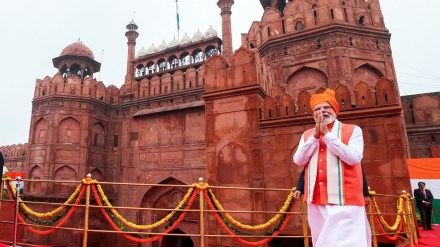From the ramparts of the Red Fort on the 79th Independence Day, Prime Minister Narendra Modi announced that India will work on developing its very own aerial defence system, ‘Mission Sudarshan Chakra’. The PM took cue from the epic Mahabharat that was fought on the land of Kurukshetra, where Lord Krishna played a crucial role in taking Pandavas to victory. A day before Janmashtami (Lord Krishna’s birthday), PM Modi told the world about Bharat’s mega defence program – Sudarshan Chakra – to be readied by 2035.
In the next decade, the country will have its own safety system in place like Israel’s much-talked-about Iron Dome and the US’ ambitious ‘Golden Dome’. It is expected that the defence system would be more than saving the country from missiles and could include cyber warfare systems to tackle the new age methods of conflict.
“…I am saying today from the ramparts of the Red Fort that in the coming 10 years, by 2035, all the important places of the nation, which include strategic as well as civilian areas, like hospitals, railways, any centre of faith, will be given complete security cover through new platforms of technology. This security shield should keep expanding, every citizen of the country should feel safe, Whatever technology comes to attack us, our technology should prove to be better than that and hence, in the coming 10 years, till 2035, I want to expand this national security shield, strengthen it, modernize it and hence, taking inspiration from Lord Shri Krishna, we have chosen the path of the Sudarshan Chakra of Shri Krishna,” the Prime Minister said.
He recalled the part of the Mahabharat when Shri Krishna had blocked the sunlight with his Sudarshan Chakra and made it dark during the day, and said, “Sunlight was blocked with Sudarshan Chakra and Arjuna was able to fulfill the oath he had taken to kill Jayadratha.”
“This is the result of the might and strategy of Sudarshan Chakra. Now the country will launch the Sudarshan Chakra Mission. This mission Sudarshan Chakra, a powerful weapon system, will not only neutralize the enemy’s attack but will also hit back at the enemy many times more,” he added.
3 Key characteristics of ‘Sudarshan Chakra’
The Prime Minister said that Sudarshan Chakra will be a crucial, methodological and well-researched defence system for the country. In the coming 10 years, he said, the research, development, and manufacturing of the entire system will be done in the country itself. This is ‘Aatmanirbharta‘, which PM Modi had urged the countrymen to continue to focus on. Also, artificial inteliigence (AI), lasers, drones and other modern warfare technologies would be critical part of the ‘Sudarshan Chakra’
“Secondly, there will be a system which will calculate the possibilities of the future in terms of warfare and work out the strategy of Plus One,” PM Modi added.
The third important characteristic of the Sudarshan Chakra is its precise power, the PM said, adding that “it went wherever it had to go and came back to Shri Krishna.” Based on the same, India will move forward with the aim of developing a system for targeted precise action through this Sudarshan Chakra.
“… and therefore, I pledge to take this work forward with great commitment for the security of the nation and the safety of citizens in the changing ways of warfare,” PM Modi said.
How will the ‘Sudarshan Chakra’ work?
India already has the Integrated Air Command and Control System in place which was the wall that Pakistan couldn’t cross while trying to attack India during Operation Sindoor in May this year.
Highlighting India’s defence self-reliance shown during Operation Sindoor, the PM highlighted how indigenous capabilities, including Made-in-India weapons, enable India to act decisively and independently, proving that national security cannot rely on foreign dependence.
#WATCH | Delhi: PM Modi says, "In the next ten years, by 2035, I want to expand, strengthen, and modernise this national security shield. Drawing inspiration from Lord Shri Krishna, we have chosen the path of the Sudarshan Chakra…The nation will be launching the Sudarshan… pic.twitter.com/cQRaYeSLvp
— ANI (@ANI) August 15, 2025
The announcement by PM Modi on Friday laid down the foundation of the high-tech security system that India will have in place by 2035. It is expected to not just protect key establishments and civilian areas, but detect and destroy any such threat in early stages as well.
So, how will it work?
The Defence Research and Development Organisation (DRDO) in January this year had presented a plan of security system, named Raksha Kavach, to safeguard the country from outside threat. Interestingly, that announcement was made right before the Republic Day and the agency also produced a tableau on the same.
Now, PM Modi declaring ‘Mission Sudarshan Chakra’ on I-Day hints at India’s intense preparations to prepare the system. The DRDO’s ‘Raksha Kavach’ is a multilayered system.
In the first layer, satellite surveillance will detect potential threats in real time. Alerts are sent to the control center, which quickly notifies the Airborne Warning and Control System (AWACS) for surveillance in the second layer.
The AWACS system reverts back to the control centre with crucial information.
In the third layer,based on these cues, long-range radar scans the area of the incoming threat and sends the signals to the command centre. The control centre creates a protected zone by neutralizing every threat which enters the zone. It directs missile launchers to intercept threats.
Further, the protected zone comprises three protection layers. Surface to air missiles to neutralise enemy missiles and aircrafts. Electronic warfare based soft kill system jams and damages the avionics and sensors of the enemy targets.
